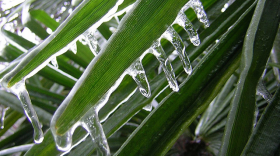The Clearwater Marine Aquarium is launching a manatee rehabilitation facility to help address the increasing number of sick and dying manatees.
Their 75,000-gallon pool at Fred Howard Park in Tarpon Springs was originally opened in 2019 to nurture injured dolphins and a strand of pilot whales that beached themselves, but aquarium officials plan to refurbish it by winter to rehabilitate distressed manatees.
They estimate it would cost $2 million to fully upgrade the facility to be able to house six manatees at a time in the 40-foot round, 8-foot deep pool. They will also upgrade two smaller 20-foot pools for the most severely injured manatees.
Aquarium staff hope to finish renovations as soon as possible, as the five federally permitted acute care facilities in Florida that treat unhealthy manatees through the Manatee Rescue and Rehabilitation Partnership are filling up quickly.

“We're running out of ‘bed space’ with all these manatees coming in. There's not enough room for them,” said James Powell, executive director of the aquarium’s research institute.
“So what we're trying to do is increase our capacity to be able to take in manatees for rehabilitation that will then eventually be released back out into the wild. And it's because we're in a crisis right now with so many manatees that are dying, or potentially starving to death.”
At least 841 of the marine mammals have died in waters near Florida’s east coast since the start of the year. That six-month total breaks the previous record set for the entire year of 2013, when 830 manatees died.
“I've been studying manatees for over 50 years — I grew up with them in my backyard in Crystal River — and I've never seen a situation like this in decades of working on them,” Powell said.
The massive number of deaths have been caused by dying seagrass in the Indian River Lagoon, one of the most important manatee habitats on the eastern part of the state.

It’s a hotspot for manatees during the winter, as waters near the area’s power plants offer more comfortable temperatures for the warm-blooded creatures.
“What has happened with increased nutrient loads and other factors that might be related to climate change is that there's been a whole series of algal blooms, not toxic algal blooms like red tide, just algae,” Powell said.
“And what that does, it decreases the clarity of the water, which decreases the amount of light that can reach the bottom. And seagrass is a grass, it needs light to grow.”
The manatee deaths on the east coast have met the criteria to be declared an unusual mortality event (UME), defined by the Marine Mammal Protection Act as "a stranding that is unexpected; involves a significant die-off of any marine mammal population; and demands immediate response."
In addition to the UME in eastern part of the state, red tide has been killing manatees in the greater Tampa Bay region.
“A lot of manatees died directly as a consequence of red tide, from the toxin from the karenia brevis,” Powell said.

Boat sales also skyrocketed during the pandemic, as more people sought to spend time outside and explore new hobbies. The National Marine Manufacturers Association reported that total boat sales were up by 13% from 2019 to 2020.
“We have this unfortunate perfect storm going on,” Powell said.
“When we're trying to protect manatees, slowing boats down, that's fairly easy to do, you can regulate that. But when we have red tide, and when we have a UME on the East Coast, that's very complex, and it's much more difficult to solve.”
If Florida does not improve its water quality to replenish sea grass and keep away threats of red tide, Powell said the manatee could end up back on the endangered species list.
He hopes that research his team collects on the manatees both during their rehabilitation and after they are released back into the wild will assist policymakers
“We make that data available to decision makers and policymakers so that it can be used in order to be able to make more informed decisions, so that conservation actions may be taken to try to do something to reduce that threat,” Powell said.
“My hope is that it's a wake up call for everybody.”
Copyright 2021 WUSF Public Media - WUSF 89.7. To see more, visit WUSF Public Media - WUSF 89.7. 9(MDAyMTYyMTU5MDEyOTc4NzE4ODNmYWEwYQ004))







